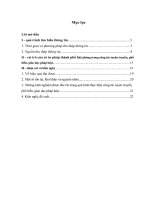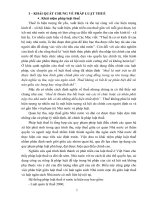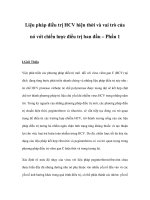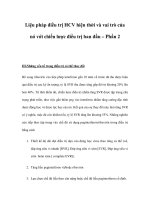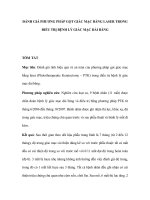Vai trò của stent tự tiêu trong điều trị bệnh lý nhiều thân mạch vành
Bạn đang xem bản rút gọn của tài liệu. Xem và tải ngay bản đầy đủ của tài liệu tại đây (3.25 MB, 28 trang )
BRS in Multivessel CAD
Faisal Latif, MD FACC FSCAI, Ramesh Daggubati, MD FACC FSCAI
Associate Chief of Cardiology
Director of Interventional Cardiology
Winthrop University Hospital
Mineola, NY USA
BVS ready for clinical use?
60 months
Symptom Severity
Yes !
Absorb A
Absorb B
Courage Trial Absorb Extend
Absorb II
Stents Vs Meds Absorb III/IV
Disease Severity
??
Syntax Trial
BVS Expand
DES Vs Surgery
#Fact 1. Despite a larger profile (ABSORB: 1.4mm, vs.
Xience 1.1mm), device success was 99.2% in B1/B2
lesions (98.3%).
In registries (e.g. ABSORB Expand), the device success
was 98.2% in complex lesions
Procedural characteristics
Absorb
Metallic DES
(n=187)
(n=365)
p-value
40.9%
35.6%
0.19
59.1%
64.4%
0.19
0.0%
0.0%
-
38.0%
48.2%
0.04
LMS
0.6%
2.2%
0.28
LAD
48.6%
53.3%
0.32
SVG
0.0%
0.0%
-
Clinical
Presentation
Stable angina
Unstable angina/
NSTEMI
STEMI
Multi-vessel disease
Treated Vessels†
Procedural characteristics
Procedural variables
Number of stents
Average Stent diameter,
mm
Total stent length, mm
Type of scaffold/
stent
Absorb
Everolimus-eluting stent
Bare-metal stent
Sirolimus-eluting stent
Others
Absorb
Metallic DES
(n=187)
(n=365)
p-value
2.16±1.32
1.51±0.83
<0.001
3.00±0.44
3.11±0.35
0.004
42.8±30.0
31.5±19.2
<0.001
100.0%
0.0%
0.0%
0.0%
96.2%
1.6%
0.0%
0.0%
0.8%
1.6%
Propensity Matched Comparison of
complete 6 months FU
• The overall follow-up rate was 95.7%.
Mortality
Myocardial infarction
Target-lesion
revascularization
Composite of death, MI
and TLR
Definite stent/scaffold
thrombosis
Acute/subacute
Late
Absorb
Drug-eluting
metallic stents
(n=187)
2.2%
1.7%
(n=365)
1.9%
0.0%
p-value
0.76
0.04
2.2%
1.1%
0.26
4.3%
3.0%
0.44
2.2%
0.0%
0.01
0.0%/0.0%
2.2%
0.0%/0.0%
0.0%
0.01
#Fact 2. Acute gain was reduced on QCA (ABSORB:
1.15mm vs. Xience: 1.46mm) and Q-IVUS (ABSORB:
2.9mm2 vs. Xience: 3.6mm2).
#Comment:
• Guidance on angiography for sizing and expansion.
• Angiography underestimate the luminal dimension
• Intravascular imaging for sizing and expansion might
have implication for FDA labeling.
Operator’s behavior
• Limited expansion of device
• Fear of scaffold disruption
• Use of a smaller postdilatation
balloon at a lower pressure
Reduced acute gain
Preparation strategy
• Protocol did not allow use
of adjunctive device
Acute recoil
• Not an issue
ABSORB FIRST REGISTRY
Diseased Vessels and Lesion Locations
RCA
LMCA 28.7%
Per Patient Analysis
# of diseased vessels
(Mean ± SD)
0.4%
1.6 ± 0.8
1 Vessel
56.6%
2 Vessels or more
43.4%
LCX
19.6%
LAD
51.3%
43.4% of patients had two or more diseased vessels
8
One Year Clinical Outcomes
Clinical Events
In hospital
1 year
0.1% (2)
0.8% (14)
0.1% (2)
0.6% (10)
MI
QMI
Non-QMI
0.7% (12)
0.1% (2)
0.6% (10)
1.4% (24)
0.4% (7)
1.0% (17)
All Revascularization
1.2% (20)
6.2% (106)
0.4% (6)
1.5% (25)
MACE
0.9% (16)
2.7% (46)
TLF (DoCE)
0.8% (13)
2.4% (40)
DMR (PoCE)
1.8% (30)
7.3% (125)
All Death
Cardiac Death
ID-TLR
Note: Clinical outcome data from those 1702 patients who complete 1 year follow-up
DoCE: device-oriented composite endpoint; PoCE: patient-oriented composite endpoint; DMR: all death, all MI, all
revascularization
9
Multivariate Logistic Regression
Predictor Analysis for TLF
Variable
Odds Ratio
P-value
Diabetes
(yes vs no)
2.24 [1.18, 4.34]
0.012
Overlap
(yes vs no)
2.44 [1.15, 4.76]
0.015
10
#Fact 2. Acute gain was reduced on QCA (ABSORB:
1.15mm vs. Xience: 1.46mm) and Q-IVUS (ABSORB:
2.9mm2 vs. Xience: 3.6mm2).
Mattesini et al. JACC 2014
=
=
=
#Fact 3. The definite scaffold/stent thrombosis rate was
0.6% (1 acute and 1 subsacute) in the ABSORB arm vs.
0% in the Xience arm.
In the ABSORB Extend registry (Ishibashi et al. EIJ 2014)
Non-Hierarchical % (n)
Scaffold Thrombosis (ARC Def/Prob)
• 2 cases
related to
interruption
of/ or
resistance
to DAPT
6 Months*
12 Months*
(N=450)
(N=450)
0.7 (3)
0.9 (4)
BVS
BVS
• 1 related to
overlap
• 1 unknown
cause
BVS overlap
2 subacute (day 6 and 29), 2 late(day 75 and 239)
#Fact 3. The definite scaffold/stent thrombosis rate was
0.6% (1 acute and 1 subsacute) in the ABSORB arm vs.
0% in the Xience arm.
Underexpansion - Yes
Overlap - Yes
Possible scaffold disruption -?
Malapposition –?
Alternance of high and low
shear stress on protruding
thick struts -?
• Thrombogenicity of PLLA –
No?
• Resistance or discontinuation
of DAPT - Yes
•
•
•
•
•
Small malapposition
Cut-off value of resolved ISA on OCT
Resolved ISA
Gutiérrez et al
2012 (Circ int)
<270μm
Kawamori et al
2013 (EHJ img)
<260μm
Mechanism of neointimal formation: Low ESS behind the strut will
lead to neointimal formation which will smooth luminal surface
RCA, Patient ID
100353-006
RCA, patient 1023
150
89
Large Uncorrectable Malapposition
18M
Post Proc
Dilemma: The vessel size is >4.0mm, while the
device size is 3.0mm…The operator is aware of
ISA, but considering the expansion limit of 3.5mm,
the operator cannot correct malapposition by
postdilatation.
1Y
Preprocedural sizing is
important!
Acute Disruption
In one patient out of 101 patients (ABSORB B study)
Overexpansion of a 3.0 mm ABSORB…
F
A
Ormiston et al.
Circ interv 2012
•
•
Pre
After Postdilatation
Stenosis in the OM branch treated
with a 3.0X18 mm ABSORB BVS
After Postdilatation with a
compliant 3.5-mm balloon at 16
atm (expected diameter, >3.96
mm), OCT shows appearances
consistent with strut breakage.
Acute Disruption
In one patient out of 101 patients (ABSORB B study)
Overexpansion of a 3.0 mm ABSORB…
Ormiston et al.
Circ interv 2012
1M later
•
•
1M later the
patient
presented with
recurrent angina
at rest.
OCT showed the
malapposed
struts in the
middle of the
lumen.
Def/Prob ST Ghost-EU registry
1.189 patients treated
with the Absorb scaffold
1.4%
Capodanno et al. Ghost EU registry, EuroIntervention 2014, ahead of print
Table 1. The rate of ST in individual populations *
Study (Journal /
international congress)
Population
Follow
up
Total,
N
Acute ST
in total,
N (%)
Subacute
ST in total,
N (%)
Early ST
in total,
N (%)
ST in
total, N
(%)
SAP,
N
ST in
SAP, N
(%)
ACS,
N
ST in
ACS, N
(%)
STEMI,
N
ST in
STEMI,
N (%)
Kraak et al., AMC Single Centre
(EIJ)
All-comers
6M
135
0(0%)
3 (2.2%)
3 (2.2%)
4 (3.0%)
82
1 (1.2%)
53
3 (5.7%)
17
0 (0%)
ABSORB FIRST (euroPCR2014)
All-comers
1M
800
0(0%)
2 (0.3%)
2 (0.3%)
2 (0.3%)
295
N/A
505
N/A
N/A
N/A
Azzalini et al. (euroPCR2014)
All-comers
N/A
339
0 (0%)
4 (1.2%)
4 (1.2%)
4 (1.2%)
N/A
3 (N/A)
N/A
0 (N/A)
N/A
1 (N/A)
Abizaid et al, ABSORB EXTEND
(EIJ)
SAP
12M
512
0 (0%)
2 (0.4%)
2 (0.4%)
4 (0.8%)
512
4 (0.8%)
-
-
-
-
Serruys et al., ABSORB B (EIJ)
SAP
36M
101
0 (0%)
0 (0%)
0 (0%)
0 (0%)
101
0 (0%)
-
-
-
-
Onuma et al., ABSORB A (JACC
int.)
SAP
60M
30
0 (0%)
0 (0%)
0 (0%)
0 (0%)
30
0 (0%)
-
-
-
-
CORONARY CTO(euroPCR2014)
SAP
6M
35
0 (0%)
0 (0%)
0 (0%)
0 (0%)
35
0 (0%)
-
-
-
-
Serruys et al., ABSORB II
(Lancet in press)
SAP / UAP
12M
335
1 (0.3)
1 (0.3)
2 (0.6)
3 (0.9%)
267
3 (1.1%)
68
0 (0%)
-
-
ASSURE registry (euroPCR2014)
SAP / UAP
12M
183
0 (0%)
0 (0%)
0 (0%)
0 (0%)
144
0 (0%)
39
0 (0%)
-
-
BVS EXPAND (euroPCR2014)
SAP / UAP
6M
200
0 (0%)
0 (0%)
0 (0%)
4 (2.2%)
N/A
N/A
N/A
N/A
-
-
Gori et al (EIJ)
ACS
1M
150
1 (0.7%)
1 (0.7%)
2 (1.4%)
4 (2.7%)
-
-
150
4 (2.7%)
66
N/A
POLAR ACS (euroPCR2014)
ACS
12M
100
0 (0%)
0 (0%)
0 (0%)
0 (0%)
-
-
100
0 (0%)
16
0 (0%)
Kajiya et al. (EIJ)
STEMI
3M
11
0 (0%)
0 (0%)
0 (0%)
0 (0%)
-
-
-
-
11
0 (0%)
Diletti et al. , BVS STEMI (EHJ)
STEMI
1M
49
0 (0%)
0 (0%)
0 (0%)
0 (0%)
-
-
-
-
49
0 (0%)
Kocka et al., PRAGUE-19 (EHJ)
STEMI
4M
41
0 (0%)
1 (2.4%)
1 (2.4%)
1 (2.4%)
-
-
-
-
41
1 (2.4%)
Wiebe et al. (Clin Res Cardiol)
STEMI
6M
25
0 (0%)
0 (0%)
0 (0%)
0 (0%)
-
-
-
-
25
0(0%)
Ielasi et al., RAI registry (EIJ in
press)
STEMI
6M
74
0(0%)
1(1.4%)
1(1.4%)
1(1.4%)
-
-
-
-
74
1(1.4%)
Average F/U: 10.6
Months
3120
0.06%
0.48%
0.54%
0.89%
1171
0.68%
410
1.71%
299
0.67%
All-comer
1189
5 (0.4%)
11 (0.9%)
16 (1.3%)
23 (2.1%)
626
9 (1.4%)
563
14
(2.5%)
192
4 (2.1%)
4309
0.16%
0.60%
0.76%
1.22%
1797
0.94%
973
2.16%
491
1.22%
When excluding the Ghost EU,
In 3120 patients with a mean follow-up of 10.6 Months,
• Acute ST: 0.06%
• Subacute ST : 0.48%
• Total ST: 0.89%
• SAP 0.68%, ACS 1.71%, STEMI 0.67%
When including the Ghost EU,
In 4309 patients with a mean follow-up of 10.3 Months,
• Acute ST: 0.16%
• Subacute ST : 0.60%
• Total ST 1.22%
• SAP 0.94%, ACS 2.16%, STEMI 1.22%
Weighted average
excluding the GHOST-EU
registry
Capodanno et al., GHOST (EIJ)
Weighted average
including the
GHOST-EU registry
6M
Average F/U: 10.3
Months
* ST= scaffold thrombosis, SAP= stable/silent angina pectoris, ACS=acute coronary syndrome, STEMI=ST-segment elevation myocardial infarction
#Fact 4. Cardiac biomarker rise < 48 hours after the
index procedure and per-protocol peri-procedural MI did
not differ between the two arms.
Postprocedural CKMB rise
in the ABSORB Extend and
SPIRIT II/III
20.0%
18.0%
17.6%
35.0%
30.0%
16.0%
14.0%
Postprocedural CKMB rise
in the ABSORB II
12.5%
20.0%
10.0%
15.0%
8.0%
10.0%
4.0%
2.0%
0.0%
ABSORB
Xience
25.8%
25.0%
12.0%
6.0%
32.1%
5.5%
5.0%
3.8%
2.5% 1.9%
1.1%
0.0%
0.6%
>1xULN >2xULN >3xULN >5xULN
13.3%
9.8%
7.1%6.1%
4.9%
2.5%
0.6%
0.6%
#Fact 4. Cardiac biomarker rise < 48 hours after the
index procedure and per-protocol peri-procedural MI did
not differ between the two arms.
Incidence of anatomic complications assessed by angiography in patients with
periprocedural MI
Absorb BVS
(N=335 pts)
3.9%
2.7%
0%
EES
(N=166 pts)
1.2%
0.6%
0%
Side branch occlusion after device implantation
2.7%
0.6%
0.18
Side branch occlusion improvement after NTG
0%
0%
1
2.7%
0.6%
0.18
0.6%
0.6%
1
Abrupt closure
Distal embolization
coronary perforation
Flow limiting dissection (NHLBI type F)
0%
0.3%
0%
0%
0.6%
0%
0%
0%
0.33
1
1
1
coronary dissection after pre dilatation (NHLBI D or E)
0.3%
0%
1
coronary dissection after device implantation
0%
0%
1
Thrombus during procedure
Disruption of collateral flow
0%
0%
0%
0%
1
1
0.6%
0%
1
Per protocol peri-procedural MI
Type 1: Side Branch Occlusion, % (N)
Side branch occlusion after pre dilatation
Side branch occlusion after procedure
Type 2: Angiographic Other Complication, % (N)
Non-indentifiable mechanism causes, % (N)
p value
0.16
0.18
1
#Fact 4. Cardiac biomarker rise < 48 hours after the
index procedure and per-protocol peri-procedural MI did
not differ between the two arms.
When the cardiac biomarker rise was subcategorized
according to contemporary PMI criteria such as the 3rd
universal definition and the SCAI definition, PMI rates
were:
•
•
•
•
5·2% vs. 2·5% (CKMB >5x ULN)
32·0% vs. 26·9% (troponin >5x ULN, 3rd Universal)
0·6% vs. 0·6% (CKMB >10x ULN, SCAI)
4·6 % vs. 1·9 % (troponin >70x ULN, SCAI)
These results strongly emphasize the arbitrary
character of any definition of PMI.
ABSORB 1-Year Meta-analysis
ABSORB II, ABSORB III, ABSORB Japan, ABSORB China
Meta-analysis summary
BVS
(N=2164)
CoCr-EES
(N=1225)
RR [95% CI]
Fixed effect
P Value
I2
P
het
0.8%
0.7%
1.12 [0.47, 2.69]
0.80
NA
NA
- Cardiac
0.4%
0.3%
1.26 [0.33, 4.82]
0.74
NA
NA
- Non-cardiac
0.4%
0.4%
1.02 [0.32, 3.25]
0.97
NA
NA
5.7%
4.0%
1.34 [0.97, 1.85]
0.08
0%
0.71
2.9%
2.2%
1.29 [0.82, 2.03]
0.27
0%
0.75
- Peri-procedural (SCAI def)
0.8%
0.8%
0.97 [0.44, 2.14]
0.94
0%
0.63
- Non-peri-procedural (AIII def)
2.8%
1.8%
1.48 [0.91, 2.40]
0.11
0%
0.93
- TV-MI
5.1%
3.3%
1.45 [1.02, 2.07]
0.04
0%
0.80
- Non-TV-MI
0.7%
0.9%
0.75 [0.34, 1.66]
0.48
0%
0.94
All-cause mortality
All MI
- Peri-procedural (AIII def)
NA = not applicable - cannot test for heterogeneity because no events were present in one cell in 3
of the 4 trials; het = heterogeneity

